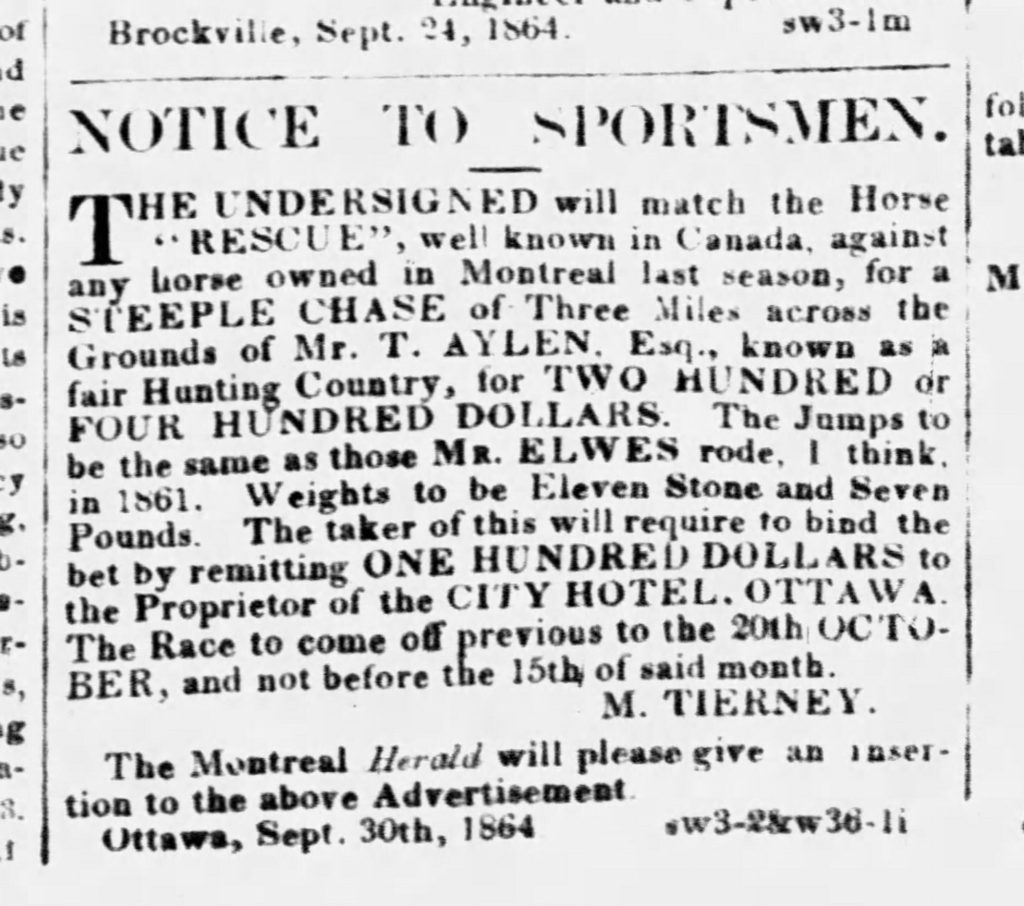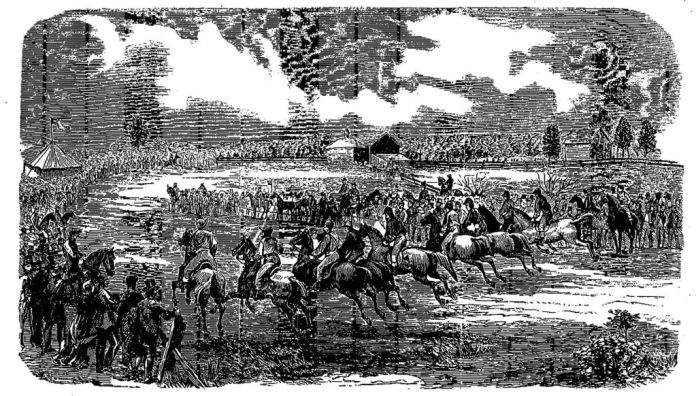By Dave Allston
Westboro is one of Ottawa’s most trendiest neighborhoods, rich with houses, shops and modern amenities. But a century and a half ago, Richmond Road was lined with farms where horses played.
During the mid-19th century, steeplechase, a distance horse race, became one of Ottawa’s most popular sporting activities, thanks to a large influx of European immigrants who recently called Canada home.
In the 1860s, major centers across the country quickly began hosting competitions to meet the need of the growing activity, including in Westboro and McKellar Park.
Better known today as a sport for human participants, particularly at the Olympic games, steeplechase had its earliest origins with participants on horses going through a course of various fences, ditches and other obstacles. The name “steeplechase” in fact originates from early competitions in Ireland which ran from one church steeple to the next.
Though post-modern Kitchissippi did not have steeples, it still served as an ideal location for the races. They were held on land offered up after the fall harvest was completed, by the pioneer Thomson family (of Maplelawn fame).
Thompson farmland stretched from Churchill west through to Wavell, and all the way south to Carling. The west half was owned by William T. Aylen, son of Janet Thomson, while the east half was owned by brothers William Jr. and John Thomson.
These farm fields were converted into a three-mile steeplechase course, capable of hosting multiple events which brought in participants from all over Carleton County and places as far away as southern Ontario and Quebec City.
Early Ottawa resident James McIsaac provided great detail of the route in a 1927 interview with the Ottawa Citizen.
“The course started on the Cole property near the Richmond Road, ran 56 rods south [to about Kenwood Avenue], and then turned and went towards what is now Woodroffe, returning on an angle to the starting point,” recalled McIsaac. “The route followed was well suited for steeplechasing as the land crossed was intersected with ditches, log fences and hedges.”
An 1864 report of a race on the Aylen-Thomson farm noted that there were 19 leaps in total on the course.
“Every fall in the early sixties there was a week of racing. All the best jumping horses came from miles around,” said McIsaac. “There were booths where whiskey was sold, and stands where eatables, meals, tobacco, candy, etc. could be had.”
The main events of October 1861 perhaps are the most memorable, not only because they were the first steeplechases ever held in the Ottawa area, but because some excellent detail of the race days survive.
Two major events were held on Oct. 24. The first was a three mile race for a purse of $300 and featured four horses named “Brunette”, “Fanny Kemble”, “Wild Irishman” and “Montcalm”.
Montcalm gave up after the third leap, and Wild Irishman lost his rider about two-thirds into the race. Fanny Kemble fell at one of the final jumps, leaving Brunette the winner, covering the distance in a reported twelve minutes.
The second race was a two mile race for $100, with three horses, “The Bird”, “Centipede”, and “Antelope” competing. The Bird and Antelope both gave up early, leaving Centipede for an easy win.
Tragedy occurred following the races when one of the spectators, Samuel Young, a farmer from Goulbourn Township,was killed instantly on Richmond Rd when he was run over by a double wagon amidst the havoc of all the horse carriages departing.

As James McIsaac recalled: “A number of farmers from near Richmond had come down in a box wagon rigged with several cross seats. The day’s proceedings were over and the party was about to start home when Mr. Young (who occupied the back seat) stood up in the wagon to wave goodbye to some friend. At that moment the horses started and Mr. Young fell backwards onto the road. His head hit the ground with great force and his skull was fractured. He died almost immediately.”
The following day, a one-on-one race was scheduled between Montcalm and Wild Irishman, for a $200 prize. The two horses were considered two of the best horses anywhere and had both come off major wins that summer (Montcalm had won the Three Rivers and Arthabaska Railroad competition as well as the Handy Cup race in Three Rivers, while “Wild Irishman” had won the Queen’s Plate in Toronto in July).
The event was not without its conflict. It had been agreed that the competitors were to meet at 12:00 p.m. at the Thomson farm, but when noon arrived, neither “Wild Irishman”, nor the race’s judge were present. Reports indicated that Montcalm’s owner then claimed the $100 prize for a forfeit win. However, the large assembled crowd insisted the race still come off, even if Wild Irishman showed up late, which he did. The race went on.
The race ended up being a very close one. As the Citizen reported: “A good start was effected, Wild Irishman taking the lead from the leap. Montcalm refused and thereby lost considerable distance. Wild Irishman keeping the lead to place of starting. On getting on hard footing, Montcalm gained on Wild Irishman – they took the last leap together resulting in Montcalm winning by one length.”
Wild Irishman clearly made a mark in the memories of many in the audience during those early steeplechase events. Seventy years later two separate remembrances of another Wild Irishman story from a race in a subsequent year were made in interviews with The Citizen, including one with James McIsaac.
McIsaac recalled that horse owners back then would “dope their animals by giving them whiskey just before a race.”
“Wild Irishman was so treated before one of the races and the whiskey had a peculiar effect on him,” remembered McIssac. “He broke away from his owners and bolted for the Richmond Road, clearing the farm fence in a beautiful jump. Then he tore east towards Ottawa, pursued by his owners and others.”
But Wild Irishman kept going. When he reached what is now the corner of Parkdale and Wellington Street, he encountered the old tollgate, which was kept by a man named Ferguson.
“Mr. Ferguson had a habit of keeping his gate shut by day as well as by night. The gate was five feet high. But a shut tollgate was nothing in the young life of this Wild Irishman. The horse never hesitated,” said McIssac. “To the great astonishment of the gatekeeper, the animal cleared the gate with ease, continuing on his way to his stable in Ottawa.”
The steeplechase in Westboro became an annual event, known eventually as the impressively-titled “Central Canada Grand Annual Steeple Chase”, which ran under the patronage of the Governor General (The Viscount Monck, GCMG PC, who would stay in the role long enough to become Canada’s first GG post-Confederation).
The event kept going for several years, likely ending when the Thomsons lost their farm in the late 1870s. Future races were largely held at locations such as the Ottawa Hunt Club and Rideau Hall.
